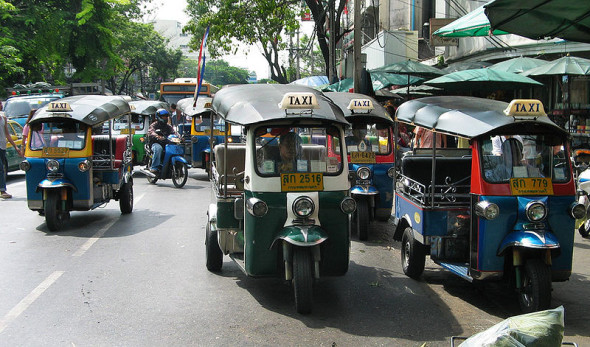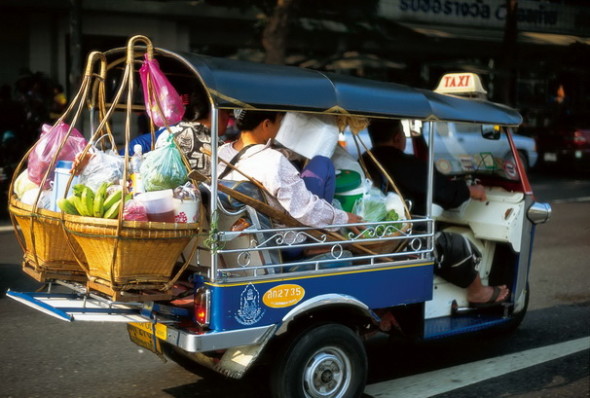
On Thailand streets, parked next to street stalls, at train stations, supermarkets and at the bottom of the steps to sky train entrances, you’ll find the Thai tuk-tuk. A tuk-tuk is a small three-wheeled vehicle (one in the front and two at the back) that runs on a motorcycle engine. Its name ‘tuk-tuk’ comes from the tuk-tuk-tuk sound its engine makes as it chugs off down the road loaded with passengers.
Ninety nine percent of the time, the tuk-tuk driver is a man, and he will drive you through any city or town in Bangkok at breakneck speed. Thais and resident expats tend to avoid them. They are dangerous, too small to get comfortable in, and there isn’t any air conditioning, so you will get to breath in more than your fair share of Thai smog.
Tourists however love them and you will often see them lined up to bargain with the driver for the fare.
Once the fare has been settled upon, the driver shoves them into the covered back, starts the engine and off they careen down the street.
Unfortunately, because the roof is low in a tuk-tuk, you have to scrunch way down in your seat to be able to see anything. Even then, you often only see the sides of cars and trucks that are too close for comfort. When you get out of a tuk-tuk, you are also covered in dirt and grime.
A thrilling exotic experience for a foreign tourist, but a nightmare for a Thai, who wants to arrive at their destination clean, pristine and cool.
The tuk-tuk however is synonymous with Thailand. It’s a brightly colored emblem of Thailand and is recognized all over the world as a true Thai gem. Surprisingly though, it wasn’t invented by a Thai. A Japanese man invented a motorized rickshaw in the 19th century and this rickshaw was eventually exported to Thailand where it was modified again.
Today there are several companies in Thailand that make the tuk-tuk body, with the engines now being made in China. It now appears in many other cities in South Asia, but Thailand is still its most famous home.
The worst thing about the tuk-tuk, I think, is the bargaining you have to do with the driver. They’ll usually try to charge more than an air conditioned taxi would charge for the same distance, and then get irritated when you try to talk them down to a lower price. A normal taxi ride from the local market to my house is around 50 baht (about $1.25).
The tuk-tuk drivers who hang around the market entrance looking for fares routinely shout 150 baht ($3.75) when I ask how much. Now considering this is still a developing country, there isn’t a Thai or a resident Westerner that would pay that much for a tuk-tuk. So the drivers are left with two choices. Either come down in price, or wait for a gullible tourist who will still think $3.75 for a 4 minute trip is cheap. Usually, they opt for the tourist.
Currently there are about 8,000 tuk-tuks in Bangkok and another 45,000 in cities and towns outside Bangkok. As time goes on, it’s becoming increasingly difficult for tuk-tuk drivers to make a living, now the era of the air conditioned taxi has securely landed, so it will be interesting to see how long these cool little vehicles stay around.

It would be such a pity though to lose this Thai marvel. There’s nothing funnier than seeing a Thai family on their way home from the supermarket in a tuk-tuk. Mum, Dad and all three kids are jammed in the back. Everybody is clutching shopping bags, with more piled around them at their feet.
Purchases such as plastic chairs, laundry baskets, sacks of rice, dried seafood are tied with rope all around the back and sides of the tuk-tuk and large items are laid on the roof.
The tuk-tuk then departs for home with everybody hanging on for grim death and the stuff tied around the sides swaying precariously and in danger of scraping every car the tuk-tuk passes. Funnily enough, nothing ever falls off and nobody seems to die.
So the next time you are in Thailand and looking for transportation, take a tuk-tuk ride and help preserve Thai culture. You may not want to do it again, but you can go home and tell your friends you defied death while squashed into a tin can on three wheels, weaving in and out of traffic in one of the most amazing places in the world.
